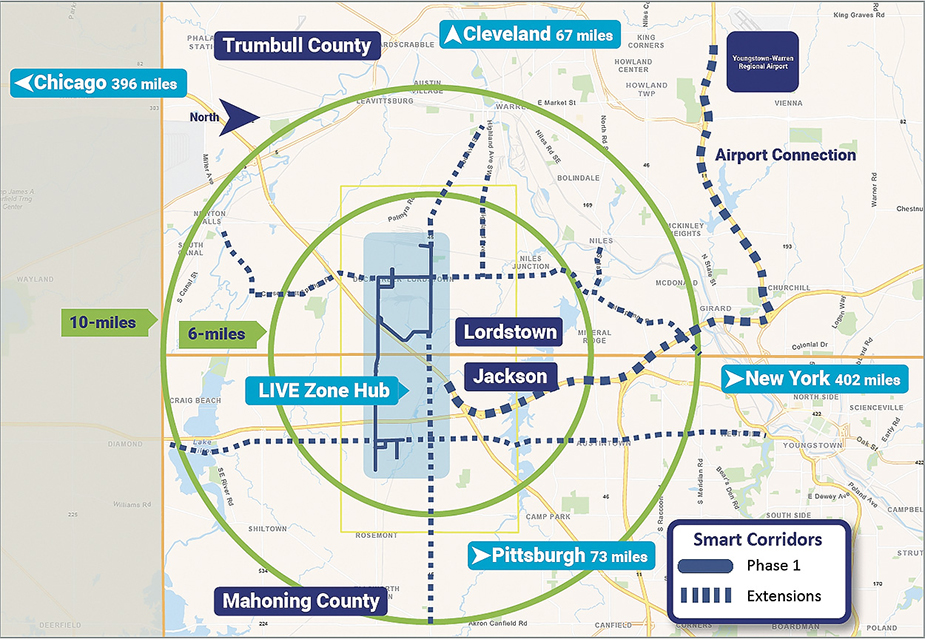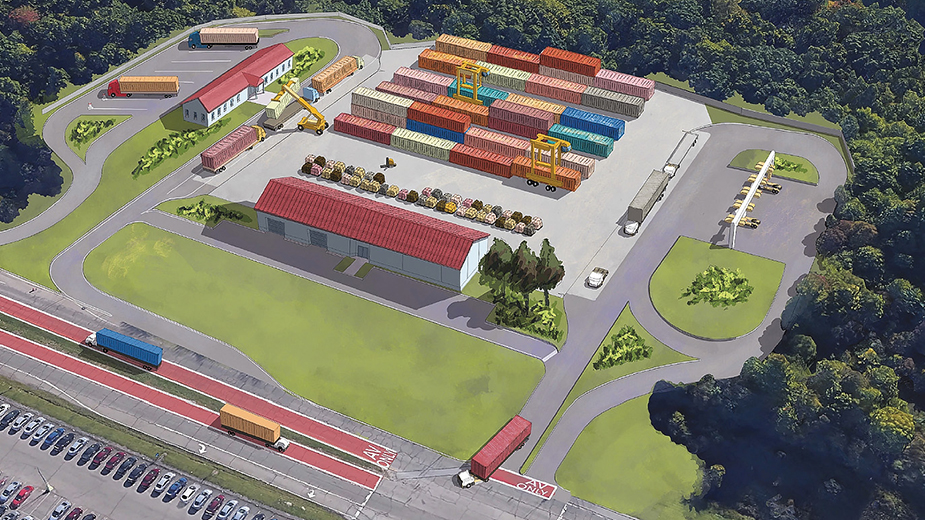YOUNGSTOWN, Ohio – The vision plays out like the business hub of the future: an intermodal yard where freight is moved without touching a single human handler. A solar energy field that helps power electric-vehicle charging stations and an advanced data communications network. Nearby, autonomous vehicles deliver cargo to users along a preordained mile-and-a-half-long route.
All of this is choreographed by technological breakthroughs in logistics management and communications systems that could redefine how manufacturers, distributors and even farmers in the Mahoning Valley ship their products. At the same time, specialists say such improvements are likely to draw new business and industry to the area, reversing a trend that is all too familiar throughout northeastern Ohio.
The result is a comprehensive and ambitious initiative: the Logistics Innovation and Vehicle Electrification, or LIVE, Zone, Jim Kinnick says. Kinnick is the executive director of the Eastgate Regional Council of Governments.
In short, the project seeks a revolutionary overhaul of infrastructure and logistics capabilities in the North Jackson/Lordstown corridor – where billions of dollars of new investment has been committed over the last three years.
“We’re really homing in on the project,” Kinnick says. Eastgate, along with a host of other partners such as the Youngstown/Warren Regional Chamber, the Western Reserve Port Authority and private sector interests, are taking the lead to secure millions of dollars in federal money for what many believe could become a transformational milestone for the Mahoning Valley.
Early next year, Eastgate plans to submit a refreshed proposal to secure $25 million from the Biden administration’s Rebuilding American Infrastructure with Sustainability and Equity, or Raise, grant program. Eastgate and its development partners expect announcements for the request for proposals, or RFPs, will be announced in the first quarter of 2024, with awards made public by the third quarter of that year.
THE PLAN
Three years ago, a local consortium of which Eastgate was part, submitted a proposal for a $25 million federal grant – then called a “Build” grant – to support a similar effort. That effort came up empty, since the logistics project was passed over because it was largely incomplete, Kinnick says.
The learning experience kicked into high gear a renewed effort to refine the plan, dig deeply into the details and develop an entirely new proposal that today includes new developments such as Foxconn and Ultium Cells’ electric-vehicle battery plant in Lordstown. The proposal also references other stakeholders in the region, such as TJX HomeGoods’ distribution center in Lordstown and an expansion of Macy’s distribution center in North Jackson.
The revised plan, prepared by Pittsburgh-based Michael Baker International and funded with a $500,000 grant from the Ohio Department of Transportation, is a more in-depth study that lays out an ambitious design that over time would transform the entire corridor north and south along Bailey Road from North Jackson to Lordstown. It would also encompass a portion of Hallock-Young Road that encircles Foxconn’s EV plant and north and south along state Route 45 in Lordstown to encompass Ultium Cells’ plant and the Ohio Commerce Park.
Anchoring the project during its initial phase would be the construction of a “smart” transfer yard along Bailey Road near the Interstate 80 interchange in Lordstown, Kinnick says. This yard would consist of an area where trucks pulling triple trailers along the interstate, for example, could unhook their trailers and leave them for retrieval. Under Ohio law, trucks cannot pull more than two trailers at a time on local highways.
Kinnick says the location could greatly benefit business and logistics in the region since the closest transfer yard is just off state Route 5 in Newton Falls. This would make it easier on major distribution hubs such as FedEx, which operates a large depot in North Jackson.
Instead of dispatching trucks to Newton Falls to retrieve trailers, FedEx and other nearby distribution operations would cut travel time in half. “They’ve been begging for it for years,” Kinnick says.
Moreover, the new yard would be outfitted with technological advances such as EV charging stations, CNG refueling, and information system connections that could transmit in real time when the cargo arrives, he says. As it stands, the transfer yard outside Newton Falls is simply a large parking lot, absent any smart technology.
Technological elements of the new transfer yard would also be applied to a second major initiative in the plan – the development of a smart intermodal complex – presumably at the Ohio Commerce Park in Lordstown.
“We’ll take it to the next level,” Kinnick says. The intermodal project would incorporate smart logistics technology that uses autonomous operations to load and unload containers transported by rail along Norfolk Southern’s line to and from the commerce park, Kinnick says.
This would include an automated trailer breakdown and container lift system, EV truck and equipment charging, and automated yard jockeys to move freight within the yard.

The vision for this area of Mahoning and Trumbull counties, however, extends well beyond autonomous logistics, Kinnick says. Other elements that are considered for the future include a solar panel microgrid, private EV charging, upgraded data networks managed through a central communications hub, and an automated transit system that could run a continuous loop between the Ohio Commerce Park and those companies along the corridor.
“I think what’s important here is that we’ve studied the area,” Kinnick says. The first proposal in 2020, for example, predated the start of production at Ultium ‘s $2.3 billion plant and Foxconn’s acquisition of Lordstown Motors Corp.’s sprawling manufacturing complex. “We felt like we were throwing things at the wall. We figured the location, interstate access and investments. But we didn’t know what we wanted to build out there.”
Since then, the prospect of attracting new business has improved exponentially as existing distribution operations expand and rumblings circulate of new major investments across the Mahoning Valley.
Kinnick says Eastgate is working closely with the Youngstown/Warren Regional Chamber’s logistics council and has engaged with local businesses and industry to assess their needs and ideas on how to make this region more prosperous.
“We’ve sat down with Foxconn twice now,” Kinnick says. “They’ve looked at it. They focused on the intermodal project and said it could be a play for them in the next couple of years.”
There are also opportunities to leverage the LIVE Zone to attract new companies engaged in the supply chain sector.
It’s imperative that domestic manufacturers today incorporate automation and technology into their business operations, says Michael Chang, president and CEO of Chang Industrial. Chang was the featured speaker at Eastgate’s annual meeting in May, and works with companies that are reshoring manufacturing operations in the United States.
“The reason is that your competitor is overseas,” Chang said during an interview after the event. “They have a lower wage base. Maybe government is supporting them. So, anything coming back to the U.S. must be done in an automated, high-tech fashion.”
Chang provided some input on the LIVE Zone vision plan. His company designs technology applications used in manufacturing plants, startups, Smart city projects and autonomous transit systems.
“Technology will be a part of any field in the future,” he says.
COMMUNITY AND ECONOMIC IMPACT
An impact analysis conducted as part of the study shows that Mahoning and Trumbull counties could realize between $600 million and $1.3 billion in economic activity as a result of LIVE Zone investments.
The study also found that potential direct and indirect employment – based on industrial land-use scenarios across target sectors such as transportation equipment manufacturing, miscellaneous manufacturing and warehousing and distribution – could range between 3,643 and 9,138 jobs.
Kinnick says funding from the Raise grant would cover the costs for the smart yard and intermodal project. The entire build-out of the smart corridor through three phases is likely to last years and would require an estimated $194 million of investment, according to the report.
Dan Crouse, an agent for Platz Realty Group who is the leasing agent at the Ohio Commerce Park, says the intermodal project would benefit the entire region.
“The big deal is the integration of rail, highways and utilities and to do it efficiently,” he says.
A smart intermodal development at the commerce park would not just serve businesses in that development. It would also help the industrial and agricultural sectors across the region, Crouse says. And the use of a railroad helps to reduce truck traffic, alleviating wear and tear on the roadways.
The key is to bring in containers by rail and then replace those offloaded with ones ready to move out of the Mahoning Valley, Crouse says. A smart intermodal yard could solve that issue.
“Think of what that does for farmers,” Crouse says. Farmers throughout the region, especially in Trumbull County, ship corn and soybeans to China and India. “If they could ship it out in full volume, the railroad can handle it. Trucks can’t.”
Such a complex at the Ohio Commerce Park would expedite shipping to the West Coast and cut in half the time it would take for grain and other food products to reach Asian ports, Crouse says. Other companies that haul product from Cleveland – he singles out Berk Paper and Phantom Fireworks – could cut their costs and receive shipments in Lordstown.
“I think it would be a boost for everybody in this valley,” Crouse says.
OPPORTUNITY KNOCKS
Recent investment by international companies such as Foxconn and Ultium Cells – a joint venture between General Motors and Korea-based LG Energy Solution – has opened the potential to attract new business to the region.
Aside from the Lordstown/North Jackson corridor’s proximity to highway (approximately 19% of the country’s truck freight moves through the I-80 and I-76 corridor daily) and rail, the area boasts plenty of land ripe for development, says David Wilaj, director of the Mahoning Valley Logistics Council, a division of the Youngstown/Warren Regional Chamber.
“We’ve got a ton of momentum out there,” he says. “It’s a perfect time to go after this.”
Wilaj says the LIVE Zone is likely to attract the attention of companies that might otherwise have overlooked the Mahoning Valley. The ripple effect would encompass a much larger swath.
Development at the Youngstown-Warren Regional Airport, Sapientia Ventures’ efforts to build new spec buildings and an industrial park in West Warren, and the former Republic Steel site – a sprawling 800-acre property that straddles Howland Township and the city of Warren – could all benefit from this project, he says.
“The build-out is going to be a huge piece when it comes to attracting companies to the area,” Wilaj says. “As our site readiness moves forward, there is a focus on all parts of Youngstown and Warren.”
Pictured at top: Architectural rendering of a smart logistics yard that is envisioned for the Lordstown corridor.
